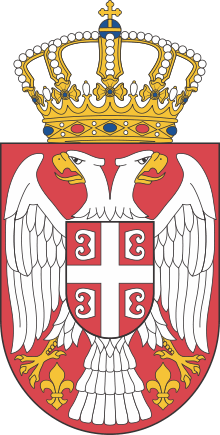NUTS statistical regions of Serbia

 |
| This article is part of a series on the politics and government of Serbia |
|
Legislature |
|
Judiciary |
Serbia is divided into five statistical regions in accordance with the Law of the Regional Development and the Law of the Official Statistics. These regions are used chiefly for statistic purposes, such as census data. The regions encompass one or multiple Districts of Serbia each.
In 2009, National Assembly of Serbia adopted the Law on Equal Territorial Development that formed 7 statistical regions in the territory of Serbia.[1] The Law was amended on 7 April 2010,[2][3][4] so that the number of regions was reduced to 5. The Eastern Serbia region was merged with Southern Serbia and Šumadija was merged with Western Serbia.
The statistical regions are:
- Vojvodina
- Belgrade
- Šumadija and Western Serbia
- Southern and Eastern Serbia
- Kosovo and Metohija[lower-alpha 1]
NUTS classification
In a bylaw from 2010, the Government of Serbia specified a nomenclature of statistic territorial units in the country.[5] The act was an attempt to synchronize the existing statistical division of the country with the Nomenclature of Territorial Units for Statistics of the European Union. According to the act, an additional top level of grouping was introduced, with the territory of Serbia divided into two NUTS 1 regions:
- Serbia-North, comprising
- Vojvodina
- Belgrade, and
- Serbia-South, comprising
- Šumadija and Western Serbia
- Southern and Eastern Serbia
- Kosovo and Metohija
The five statistical regions would therefore become NUTS level 2 regions, while the Districts of Serbia would correspond with level 3. However, the classification has remained largely in internal, and limited, use within Serbia. As of 2013, it has not been sanctioned by the European Union. According to a 2011 whitepaper by ESPON, which discusses the possibility to include Albania, Serbia, Montenegro, Bosnia and Herzegovina and Kosovo into NUTS nomenclature, "the statistical NUTS1 and NUTS2 regions created by the government in order to meet the NUTS criteria as well as the requirements of the EU regional policy, do not have actually a considerable administrative power; also, they are not self-governed entities. The political criterion prevailed for their creation."[6]
See also
Notes
- ↑ Kosovo is the subject of a territorial dispute between the Republic of Kosovo and the Republic of Serbia. The Republic of Kosovo unilaterally declared independence on 17 February 2008, but Serbia continues to claim it as part of its own sovereign territory. The two governments began to normalise relations in 2013, as part of the Brussels Agreement. Kosovo has received recognition as an independent state from 110 out of 193 United Nations member states.
References
- ↑ Sedam regiona za ravnomerniji razvoj (in Serbian), Politika, 5 June 2009
- ↑ ZAKON o izmenama i dopunama Zakona o regionalnom razvoju, National Assembly of Serbia
- ↑ Uvrede, optužbe, alkotest i regioni (in Serbian), B92, 7 April 2010, retrieved 14 October 2013
- ↑ . (in Serbian), emportal, 4 February 2010
- ↑ Government of Serbia (2010), Uredba o nomenklaturi statističkih teritorijalnih jedinica (PDF) (in Serbian), Official Gazette of the Republic of Serbia, p. 2
- ↑ Analysis of the availability and the quality of data on Western Balkans and Turkey (PDF), ESPON, March 2011, pp. 25–26